Published 12:12 IST, August 14th 2020
Beirut explosion: Lebanon's historical structures at risk of collapse, says UNESCO
UNESCO on August 13 warned that at least 60 historic buildings in Lebanon's Beirut are at risk of collapse following the devastating twin explosions.

The United Nations' cultural body UNESCO on August 13 warned that at least 60 historic buildings in Lebanon's Beirut are at risk of collapse following the devastating twin explosions on August 4. UNESCO said that Dr. Sarkis Khoury, Director-General of Antiquities at the Ministry of Culture of Lebanon, informed the organisation that at least 8,000 buildings, many concentrated in the old districts of Gemmayzeh and Mar-Mikhaël, were affected by the explosions. Dr. Khoury informed that out of the 8,000 buildings affected by the blasts, 640 are historical structures, of which 60 are at risk of collapse.
Dr. Khoury also stressed on the need for urgent structural consolidation and waterproofing interventions to prevent further damage of historical buildings from approaching autumn rains. UNESCO as its first step to mark the ongoing commitment has mobilised leading cultural organisations and experts from Lebanon and abroad to coordinate emergency and longer-term measures to safeguard the city’s severely damaged cultural heritage and rehabilitate its cultural life.
"The international community has sent a strong signal of support to Lebanon following this tragedy. UNESCO is committed to leading the response in the field of culture, which must form a key part of wider reconstruction and recovery efforts," said Ernesto Ottone R., Assistant UNESCO Director-General for Culture.
Read: Brazil's Government Sends Humanitarian Aid Mission To Beirut
Beirut explosion
Lebanon's capital Beirut was struck by massive explosions on August 4 killing at least 158 people and injuring thousands of others. According to reports, the explosion was caused by 2,700 tonnes of ammonium nitrate, equivalent to 1.2 kt of TNT, that was unsafely stored at Beirut port since 2014 and was purportedly triggered by an intense fire nearby the warehouse. The blast that left nearly 3,00,000 people homeless is said to be among the most powerful non-nuclear explosion in recorded history.
(Image Credit: AP)
Updated 12:12 IST, August 14th 2020





